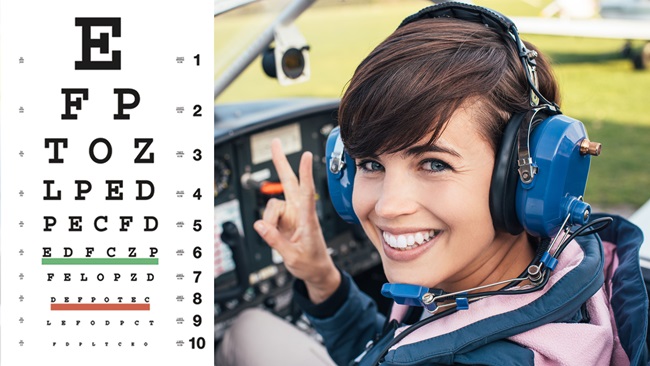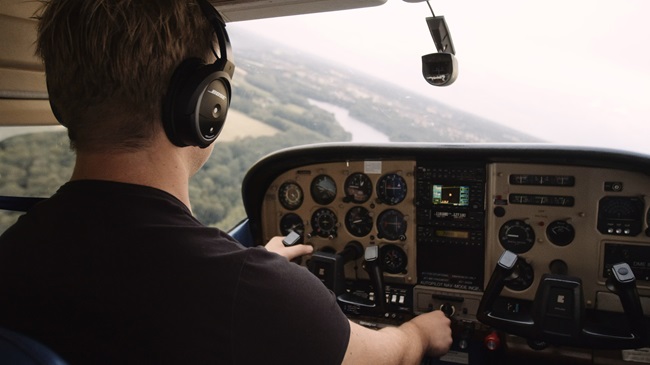| ||||
| | FT News | Inside AOPA | TRAINING PRODUCTS | FINAL EXAM | |||
TRAINING TIPsNight-flying weather "Usually, the first indication of flying into restricted visibility conditions is the gradual disappearance of lights on the ground. If the lights begin to take on an appearance of being surrounded by a halo or glow, the pilot should use caution in attempting further flight in that same direction," says the discussion of night flight in Chapter 10 of the FAA's Airplane Flying Handbook. Horizontal visibility may suddenly deteriorate as you descend through a layer of fog, haze, or smoke. Calm surface winds often accompany night flight. But a surprise may be waiting slightly higher up thanks to a strong low-level flow or wind shear caused by a nocturnal temperature inversion. "Imagine taking off on what seems like a calm night only to run into a 30-knot or stronger wind only a few hundred feet above the runway. The worst case would be a wind coming from the airplane's tail. A sudden 30-kt or stronger tailwind would rob the wings of some lift, which would probably cause you to lose some altitude before regaining airspeed," wrote Jack Williams, explaining the various hazards in the May 2004 AOPA Flight Training column "The Weather Never Sleeps: Shear energy." During any night flight, stay alert for the possibility of ground fog. As the AOPA Air Safety Foundation's Weatherwise Safety Advisor explains: "The temperature-dew point spread decreases as the temperature drops, usually in the very early morning and at night. Fog is most likely to occur at these times and can form quickly after sundown or at sunrise." Monitor that spread throughout your flight—and know where you'll go if a quick reaction is needed. Remember: Even when the night sky is clear and the visibility unrestricted, fog can close in below. The well-prepared pilot knows which way provides a safe escape. YOUR PARTNER IN TRAININGPilots can never have enough information about the airports to which they fly. Instrument-rated pilots have long known that U.S. terminal procedures—also known as instrument approach charts—are bountiful sources of such information. You don't have to be instrument rated to use them. For example, an airport diagram is part of every approach chart, and for VFR pilots, it is perhaps the chart's most informative component. AOPA's Airport Directory Online contains current airport approach charts, as well as other important airport information available online only to AOPA members—and it's free!
Did you know that student pilots who join AOPA are three times more likely to complete their flight training? Membership includes unlimited access to aviation information by phone (800/USA-AOPA, weekdays from 8:30 a.m. to 6 p.m. Eastern time) or from AOPA Flight Training Online or AOPA Online. If you're not already a member, join today and get the pilot's edge. Login information is available online.
FLIGHT TRAINING NEWSChart availability could be compromised in 2009If you're accustomed to strolling into your flight school or fixed-base operator and picking up a chart whenever you need one, that flexibility could vanish in 2009. The FAA wants to reduce the number of chart vendors to only those that sell at least $5,000 worth of charts annually. Currently, businesses need to sell more than $500 worth per year to be a charting agent. The new threshold would take place Oct. 1, 2009. AOPA is concerned that plan could mean a potential loss of access to safety materials, and increased costs to end users. Read more >> Helicopter association honors Texas flight instructorHelicopter Association International (HAI) has named Kevin C. Brandt the 2009 outstanding certified flight instructor. Brandt is senior flight instructor at Bell Helicopter in Fort Worth, Texas, where his specialty is transition and recurrent training for standard flight maneuvers and emergency procedures. HAI cited Brandt's "calm and confident demeanor in the demanding environment of helicopter flight instruction," which "creates an atmosphere of trust, allowing for a most productive learning experience." On top of his experience, knowledge, and quest to provide challenging yet structured lessons, Brandt is said to have a rapport with students that makes him one of the most requested instructors for recurrent training at the Bell Flight Training Academy. HAI will recognize Brandt and other winners at its Salute to Excellence awards banquet on Feb. 23, 2009, in Anaheim, Calif. Anatomy of a runway incursionA runway incursion that occurred at Daytona Beach International Airport in 2007, involving a Cessna 182 and a Beech King Air 200, has been made a case study by the FAA and the AOPA Air Safety Foundation. The foundation's Web site offers an animated replay of the event, including air traffic control audio tapes. Runway incursions—where an aircraft, other vehicle, or person enters or crosses a runway without permission—continue to be a concern to all segments of aviation. After you view the scenario, supplement your knowledge by taking the foundation's interactive Runway Safety course. Brand-new maintenance class gets right to workThey started classes in October, but the students of a new aviation maintenance program already have their first job: refurbishing an aircraft owned by the Georgia State Patrol Aviation Unit. Students enrolled in Coosa Valley Technical College's AMT program will fix up the paint and interior of a twin-engine Cessna. Georgia State Patrol will purchase supplies needed to complete the job, which is expected to take about one year, according to a report in the Georgia Calhoun Times . The Aviation Unit performs search and rescue missions, manhunts, transportation of state officials, aerial photography and surveillance, and SWAT missions, among other services.
Inside AOPABoyer presented first annual 'Let's Go Flying Award'Retiring AOPA President Phil Boyer is the first recipient of a perpetual award named in his honor, the "Phil Boyer Let's Go Flying Award." Bill Trimble, chairman of the AOPA Board of Trustees, presented the award to Boyer on Dec. 11 at a gathering of industry and political leaders in Washington, D.C. "One of Phil's driving passions since arriving at AOPA 18 years ago has been encouraging more people to learn to fly. There is nothing Phil cares more about," Trimble said. Under Boyer's leadership, in 2008 AOPA launched the Let's Go Flying initiative. The new Web site is designed to become the single destination for all potential pilots. Read more >> This airplane has been aroundAOPA's 2008 Get Your Glass Sweepstakes Piper Archer has a long history. That's not surprising for an airplane built in the mid-1970s. What might surprise you is to learn who has owned it, flown it, and restored it. N208GG, the current registration number, is the airplane's third! Learn more in this week's sweepstakes update. AOPA logo merchandise a great gift for the holidaysAt the holidays, don’t settle for just want any watch or any wallet. The items that make up the AOPA Collection are a great way to show you’re proud to be a pilot and an AOPA member. The AOPA Collection has something for every taste and need: high-quality chronographs, leather jackets, wallets, and an array of items to be custom-embroidered. And don’t forget that every purchase made from the AOPA Collection benefits AOPA and helps pay for protecting your privilege to fly. Check out the AOPA Collection today. TRAINING PRODUCTS'Cockpit Procedures'A new book published by Aviation Supplies and Academics outlines effective cockpit routines for pilots and virtual aviators. Cockpit Procedures, by Chris Burger, describes the underlying principles for and detailed descriptions of checklists and routines used in many flight schools. Burger discusses good habits to develop, effective workload management, and even what you should have in your flight bag. The author is a flight instructor and pilot examiner and has been an air traffic controller. He operates a flying school in South Africa. The softcover book is 144 pages and sells for $19.95. Order online or contact ASA at 800/ASA-2FLY.
Note: Products listed have not been evaluated by ePilot editors unless otherwise noted. AOPA assumes no responsibility for products or services listed or for claims or actions by manufacturers or vendors. FINAL EXAMQuestion: I know that as a private pilot applicant I am required to complete a solo cross- country flight that is at least 150 nm total distance. Is there a maximum distance that I can fly on my solo cross-country? Can I literally fly across the country?
Answer: FAR 61.109 requires that the cross-country flight be a minimum of 150 nm total distance. There is no maximum distance given. If your instructor approves the flight, you can fly as far across the country as you like. Keep in mind your instructor will need to review your plan and the weather on the day of your flight, so an overnight trip may not be feasible. To make your flight planning even easier, check out the new AOPA Internet Flight Planner.
Got a question for our technical services staff? E-mail to [email protected] or call the Pilot Information Center, 800/872-2672. Don't forget the online archive of "Final Exam" questions and answers, searchable by keyword or topic. What's New OnlineA 17-year-old pilot and his friends get more than they bargained for when they depart South Lake Tahoe later than planned after a short getaway. Read more in the latest installment of "Never Again Online." If you like what you learn from these pilots' first-hand accounts in "Never Again," be sure to listen to more stories in AOPA's Never Again Podcast directory. Picture PerfectPilots love to take photos, and they love to share them with other pilots. Now you can upload your flying photos to our brand-new online gallery, "Air Mail." Share your special aviation images, or view and rate more than 475 photos and counting. Highly rated photos will get put into rotation on the AOPA home page! AVIATION EVENTS & WEATHER To submit an event or to search all events in the calendar visit AOPA Online. For airport details, including FBO fuel prices, see AOPA's Airport Directory Online. Flight Instructor Refresher ClinicsThe next AOPA Air Safety Foundation Flight Instructor Refresher Clinics are scheduled in San Antonio, Portland, Ore., and Rochester, N.Y., Jan. 3 and 4. For a complete schedule, see AOPA Online.
Can't make it in person? Sign up for the CFI Refresher Online. | Advertisers Got news? Contact ePilot. Having difficulty using this service? Visit the ePilot Frequently Asked Questions now at AOPA Online or write to [email protected]. |
| This issue of ePilot was created for &fname; &lname; at &*TO; Member Tools : Send feedback | Update member profile | Change email address | Unsubscribe | ePilot Archive Editorial Team : ePilot Editor: Alyssa Miller | Contributors: Warren Morningstar, Alton Marsh |







